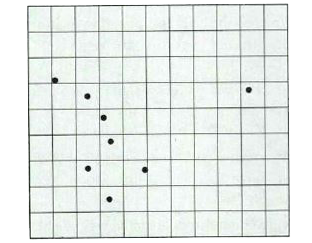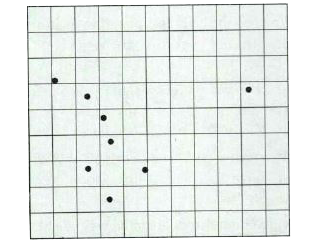Look at the sky on a dark,clear night.
You see the entire sky dotted with countless stars some bright and some not so bright Observe them carefully.
Do all of them appear to twinkle?
The correct Answer is:No,all the stars do not appear to twinkle.
Knowledge Check
- Question 1 - Select One
When we look at the sky in a clear night, we find the sky full of stars, filling every. portion of the sky almost uniformly. But on a very careful observation through highly sophisticated instruments, one would observe dark areas in portions of the observable universe devoid of stars. Such a region is known as a dark nebula. A dark nebula is basically a cold gas cloud in interstellar space that contains enough material to block out light from stars behind it. A typical dark nebuta is about 20 light years in diameter and contains about 50 hydrogen atoms per cubic centimeter (monatomic hydrogen, not H2) at a temperature of about 20 K. (A light year is the distance light travels in vacuum in one year and is equal to 9.46×1015m).
Whal would be the pressure inside a dark nebula?A1.4×10−12PaB2.8×10−14PaC2.8×10−12PaD1.4×10−14Pa - Question 1 - Select One
When we look at the sky in a clear night, we find the sky full of stars, filling every. portion of the sky almost uniformly. But on a very careful observation through highly sophisticated instruments, one would observe dark areas in portions of the observable universe devoid of stars. Such a region is known as a dark nebula. A dark nebula is basically a cold gas cloud in interstellar space that contains enough material to block out light from stars behind it. A typical dark nebuta is about 20 light years in diameter and contains about 50 hydrogen atoms per cubic centimeter (monatomic hydrogen, not H2) at a temperature of about 20 K. (A light year is the distance light travels in vacuum in one year and is equal to 9.46×1015m).
What would be the mean free time (average time between collisions)A6.4×108sB3.2×108sC6.4×109sD3.2×107s - Question 1 - Select One
When we look at the sky in a clear night, we find the sky full of stars, filling every. portion of the sky almost uniformly. But on a very careful observation through highly sophisticated instruments, one would observe dark areas in portions of the observable universe devoid of stars. Such a region is known as a dark nebula. A dark nebula is basically a cold gas cloud in interstellar space that contains enough material to block out light from stars behind it. A typical dark nebuta is about 20 light years in diameter and contains about 50 hydrogen atoms per cubic centimeter (monatomic hydrogen, not H2) at a temperature of about 20 K. (A light year is the distance light travels in vacuum in one year and is equal to 9.46×1015m).
If the space around the nebula were a vacuum thenAit would remain stableBIt would evaporateCIt would collapse into itselfDit would make a hollo
Similar Questions
What were the early ideas of men about the sky and the earth ? They naturally believed . that the earth was motionless, and they also supposed that it was flat. These two ideas do not surprise us. Children now-a-days think the same until they are taught differently. How were men to know that the earth was a ball circling round the sun ?They had no telescope for accurate observation. They had not travelled round the world. In fact, many parts of the world in those days were unexplored and unknown. They thought they lived on a kind of flat plate, and that the -isky with the sun and the moon and the stars, was a kind of inverted bowl turning round above "them. The sun, the moon and the stars were their lamps for day and night.
What was true for the early man ?View SolutionWhat were the early ideas of men about the sky and the earth ? They naturally believed . that the earth was motionless, and they also supposed that it was flat. These two ideas do not surprise us. Children now-a-days think the same until they are taught differently. How were men to know that the earth was a ball circling round the sun ?They had no telescope for accurate observation. They had not travelled round the world. In fact, many parts of the world in those days were unexplored and unknown. They thought they lived on a kind of flat plate, and that the -isky with the sun and the moon and the stars, was a kind of inverted bowl turning round above "them. The sun, the moon and the stars were their lamps for day and night.
The early ideas of man were wrong becauseView SolutionWhat were the early ideas of men about the sky and the earth ? They naturally believed . that the earth was motionless, and they also supposed that it was flat. These two ideas do not surprise us. Children now-a-days think the same until they are taught differently. How were men to know that the earth was a ball circling round the sun ?They had no telescope for accurate observation. They had not travelled round the world. In fact, many parts of the world in those days were unexplored and unknown. They thought they lived on a kind of flat plate, and that the sky with the sun and the moon and the stars, was a kind of inverted bowl turning round above "them. The sun, the moon and the stars were their lamps for day and night.
Unless children are taught differently they think thatView SolutionTo locate Pole star, you have to look at the two stars at the end of Ursa Major as shown. Imagine a straight line passing through these two stars. Extend this imaginary line towards the north direction. On this line you can locate a star which is not too bright and around which there are no stars. It is the Pole Star. The pole star always appears to remain at the same position in the sky.

Read the passage and try to answer the question
The stars that we see in the sky are not fixed at one point. Explain why?View SolutionTo locate Pole star, you have to look at the two stars at the end of Ursa Major as shown. Imagine a straight line passing through these two stars. Extend this imaginary line towards the north direction. On this line you can locate a star which is not too bright and around which there are no stars. It is the Pole Star. The pole star always appears to remain at the same position in the sky.

Read the passage and try to answer the question
Name one star in the sky that appears to be fixed at one point.View SolutionTo locate Pole star, you have to look at the two stars at the end of Ursa Major as shown. Imagine a straight line passing through these two stars. Extend this imaginary line towards the north direction. On this line you can locate a star which is not too bright and around which there are no stars. It is the Pole Star. The pole star always appears to remain at the same position in the sky.

Read the passage and try to answer the question
What is the significance of pole star for astronomers and travelers in ancient times?View SolutionTo locate Pole star, you have to look at the two stars at the end of Ursa Major as shown. Imagine a straight line passing through these two stars. Extend this imaginary line towards the north direction. On this line you can locate a star which is not too bright and around which there are no stars. It is the Pole Star. The pole star always appears to remain at the same position in the sky.

Read the passage and try to answer the question
Give the location of this star.View Solution

